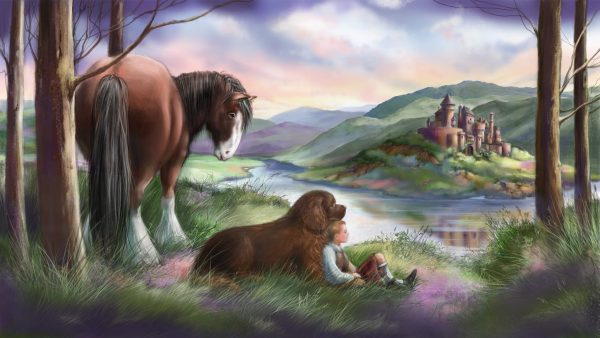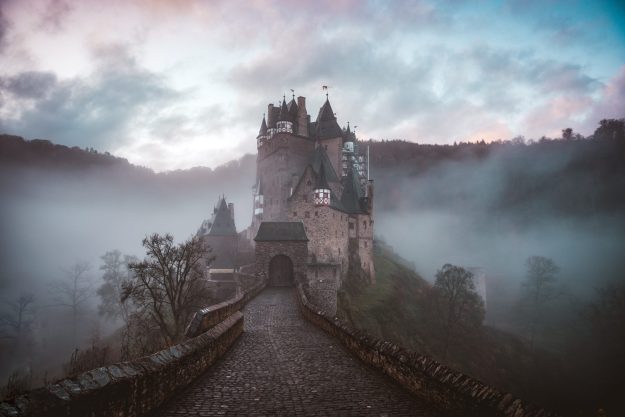
The backdrop seen behind a Newfoundland is often wet: The dog swimming, performing a water rescue in a lake or ocean, dipping a nose into the ocean. You get the idea. The breed isn’t typically associated with medieval castle life, and you won’t see such a portrayal here beyond the artwork by Patricia Eubank seen here.
That said, we came across an exception.

Photo of Eltz Castle by Cederic Vandenberghe/unsplash
Eltz Castle is a medieval castle that sits atop a boulder in a hidden German valley. Built to secure the trade routes between Mosel, Maifeld and Eifel, remnants of Celtic and Roman fortifications are found here, too. The majority of ancient castles were demolished during a war in Central Europe, but somehow, Eltz Castle remained unscathed despite its strategic war placement and having been attacked with catapults. It is one of only three castles in the Eifel region that have never been destroyed.
Also known as Burg Eltz, the castle has eight towers soaring up to 115 feet high. “Knights Hall” was where the Knights of Eltz held their meetings, and it is notable for the jester heads along the walls. Back in the day, jesters could joke about anything without being punished because it was seen as humor. As such, jesters represented free speech, but they were also a tacit warning to people: Don’t take yourself too seriously.

Eltz Castle by op23/Unsplash Photos
With oriole windows, roofs, timber frame structures and turrets, Eltz Castle is the consummate medieval castle.
What we find remarkable is that the same family has owned Eltz Castle since the 12th century. That’s thirty-four generations of the Eltz family which at one point split into three branches. All three branches have, at various times, cohabitated in the castle.
We wanted there to be a dog in the story of this family and its castle, and recently, we reached out to them to ask. Sadly, we were told there is no dog, let alone a particular breed in the family.
But wait.
The castle opened for tourism sometime around 1820, and while some of the Eltz family maintains living-quarters in the castle, Eltz Castle has been inhabited mainly by castellans for quite some time. “Castellan” is the historic expression for a caretaker or governor entrusted to oversee a castle for its lord – some would call them “managers.” The castellans live at the castle permanently and they currently keep a Newfoundland named, “Johanna,” as well as a mixed-breed dog called “Wilhelmine.” Unfortunately, our contact at Eltz Castle was not able to provide photos of Johanna, but we came across a photograph by Marta Mutti that offers a sense of what a large black dog in front of the castle looks like. Click here to see Ms. Mutti’s image.
Top image: “Clydesdale, Newfie, and Castle” by Patricia Eubank is available for purchase here.
